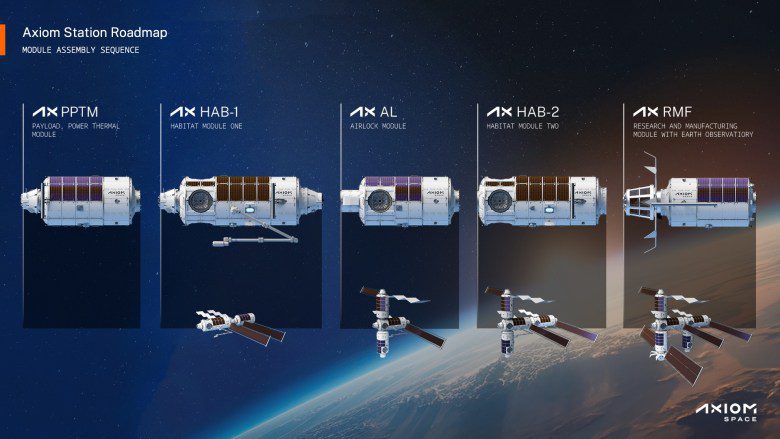WASHINGTON — Axiom Space is revising the assembly sequence for its commercial space station, a move it says will allow it to get to a free-flying station sooner while addressing NASA’s needs to prepare for the deorbiting of the International Space Station.
The company announced Dec. 18 a revised sequence of modules it will deploy through the end of the decade to assemble its Axiom Station, starting with a Payloads Power Thermal Module (PPTM) that will be installed on the ISS.
Axiom originally planned to install a habitat module on the ISS in late 2026, followed by a second habitat module and a research module. Finally, a power and thermal module, with an airlock, would be attached, allowing those modules to undock from the station around the end of the decade to be a free-flying station.
One issue with that approach, Axiom executives said in an interview, is that the company would have installed those modules on a docking port called Node 2 Forward on the ISS under an agreement with NASA in early 2020. That is the port that will later be used by the U.S. Deorbit Vehicle (USDV), the spacecraft that will provide the final maneuvers to deorbit the station into the South Pacific at the end of its life.
NASA approached Axiom earlier this year to find ways to deconflict USDV from the Axiom modules. One option would have been for the USDV to dock to the Axiom modules. “That potentially presents a risk to Axiom if, for some reason, they had to deorbit and we weren’t ready to separate,” said Mark Greeley, chief operating officer of Axiom Space and program manager for Axiom Station.
The company decided to revise the sequence of the station’s assembly. It will now start with the PPTM, which includes power and thermal systems as well as eight science racks for research payloads. Rather than dock PPTM to Node 2 Forward, it will instead berth to one of two ports currently used by cargo spacecraft like Cygnus.
“The huge advantage here to both NASA and Axiom is the fact that they do not have to reconfigure the forward port,” said George Motter, chief engineer and architect of Axiom Station. “They can bring the deorbit vehicle at any time. They can prepare for deorbit on their schedule, and once we arrive, we can stay there for a short time or a long time. We’re not in the way.”
Axiom would then launch the first habitat module, Hab1. However, rather than dock it to the ISS, the PPTM would depart the ISS and dock with the habitat module, enabling a free-flying station with just two modules, supporting four crew members. That could take place as soon as 2028, the company said, sooner than previous plans.
“The dream sequence would be to go to ISS, be there for a bit, wait for Hab1 to launch, leave ISS and dock fairly directly with Hab1,” Motter said. However, both the habitat module and the PPTM have the ability to loiter in orbit independently if needed.
Once the station is free flying, Axiom will add an airlock module, a second habitat module and a research module. Each module will have its own power and thermal capabilities, and the first habitat module also has a robotic arm used to reconfigure the station.
Thales Alenia Space Italia (TASI) is producing the modules for Axiom. It has started work on the PPTM by using components that were originally manufactured for the two habitat modules. Motter said TASI will deliver the PPTM to Axiom in 2025 for final outfitting and a launch no earlier than 2027.
How long PPTM remains at the ISS before departing to link up with the first habitat module remains to be determined. “We can stay for a short period of time, or we can extend that stay,” said David Romero, deputy program manager for Axiom Station. “We have the ability to spend time up there, testing, practicing, learning how to operate in space, burning down some of the risks.”
He added the company could transfer some ISS payloads and equipment to the PPTM before it departs, particularly if that takes place close to the end of the life of the ISS. “You want to be there as long as they can accommodate us. We also want to be there as close to the end of life as possible, so they’re ready to give up that equipment and let it move over to our vehicle.”
With the PPTM installed on the station, but without a habitat module, Axiom plans to continue to send private astronaut missions, or PAMs, to the ISS. The company has flown three to date and is training the crew for the fourth mission, now projected to launch in spring 2025. However, Axiom will have to compete for limited PAM opportunities offered by NASA.
Greeley said the revision does not change the overall cost of Axiom Station, which the company has not disclosed. “It does favorably impact our cash flow needs,” he said. “It really is just a matter of phasing our cash flow needs to accommodate the new sequence.”
“In a sense, we’re a station in two [launches] instead of a station in four,” Motter said, with full capability added in a third launch of the airlock module. “The two gives us everything you need to be a functioning space station.”
Related
Read our previous article: Frontgrade Gaisler Leads European Initiative for Ultra Deep Sub-Micron Semiconductor Technology for Space Applications
